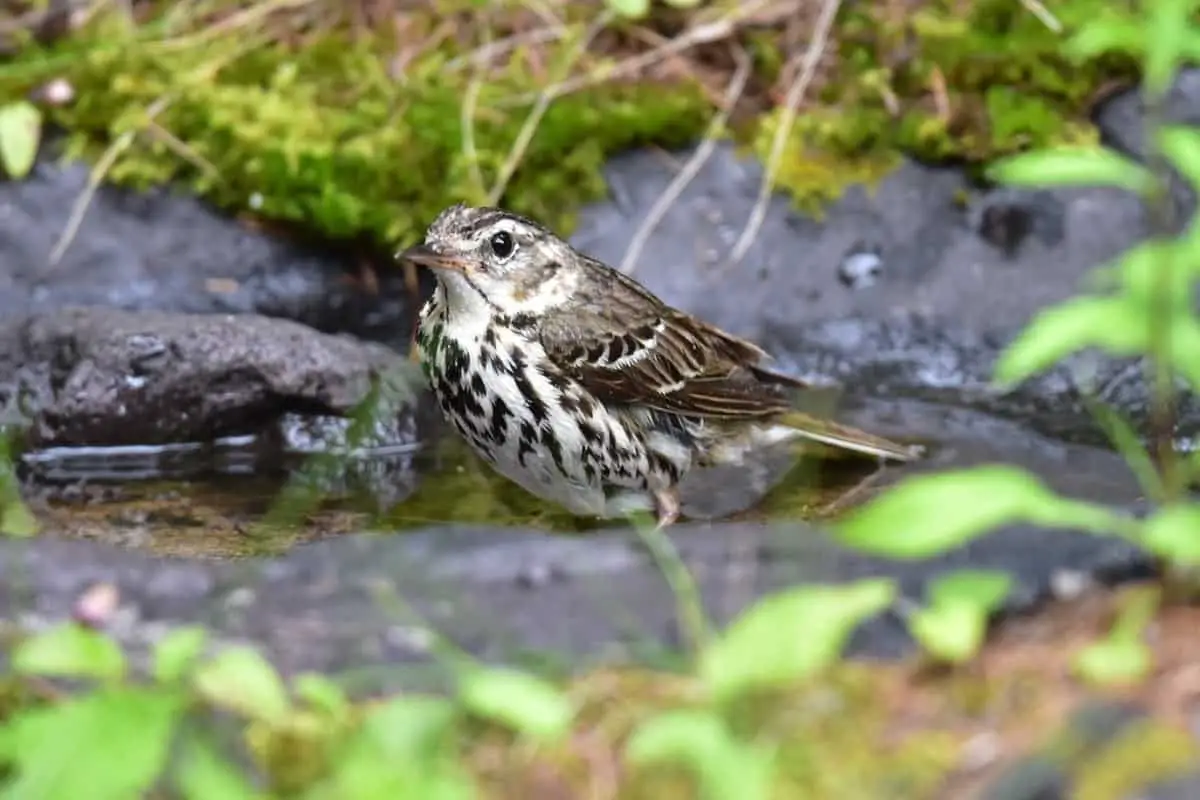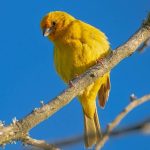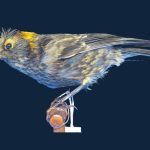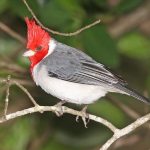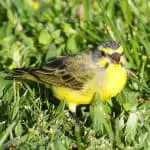Common Name: Olive-backed Pipit
Scientific Name: (Anthus hodgsoni)| Size | Diet | Range in Hawaii | Status in Hawaii |
|---|---|---|---|
| 5.5 in. - 6 in. | small invertebrates | Unknown | Least Concern |
The Olive-backed Pipit (Anthus hodgsoni), also known as the Indian Tree Pipit, is a small and charming bird species that is native to Asia. With its distinctive olive-green and white plumage and melodious singing, this pipit is a beloved sight in its natural habitat.
However, the species is also known to make appearances as a non-breeding visitor and vagrant in Hawaii, where it is a rare and exciting sighting for birdwatchers. In this article, we’ll explore the fascinating world of the Olive-backed Pipit, its unique adaptations, and its behavior in the wild.
Olive-backed Pipit
Appearance
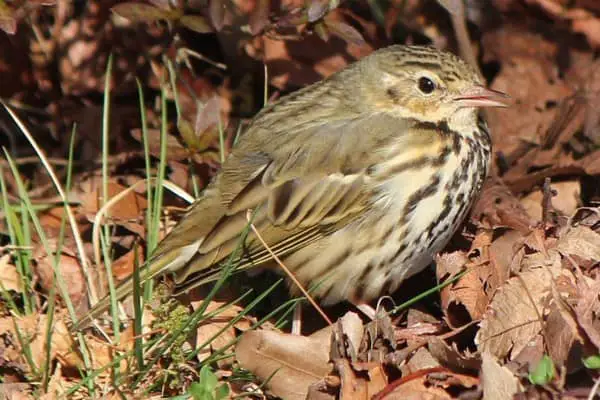
via Wikimedia Commons | CC BY-SA 3.0
The Olive-backed Pipit is a small, slender bird with a relatively long tail and pointed wings. It measures approximately 5.5 to 6 inches (14 to 15 centimeters) in length.
In terms of plumage, adult Olive-backed Pipits have a mix of olive-brown and buff coloration on their upperparts, which helps them blend in with their grassy habitats. The underparts are whitish with streaks of dark brown or black on the breast and flanks. They have a pale eyebrow stripe and a distinct dark eye line. The bill is thin and pointed, suitable for catching small insects and seeds.
During the breeding season, male Olive-backed Pipits may display a more pronounced contrast in plumage, with brighter colors and more distinct streaking on the breast. Females and juveniles have a similar appearance but may be slightly duller overall.
Diet
The diet of the Olive-backed Pipit primarily consists of small invertebrates, especially insects and their larvae. They forage on the ground, often in grassy areas or open fields, searching for prey such as beetles, ants, grasshoppers, and spiders. They also feed on small seeds and occasionally consume berries or other plant material when insects are scarce.
Olive-backed Pipits use their sharp bill to probe the soil and foliage for their prey, and they may also perform short flights to catch flying insects. During the breeding season, they may feed their young with a diet consisting mainly of insects.
Nesting
The Olive-backed Pipit builds its nest on the ground, typically hidden among vegetation or in a grassy area. The nest is cup-shaped and constructed from grass, moss, and other plant materials. The female takes the lead in building the nest, while the male may assist in gathering materials.
The female lays a clutch of 3 to 5 eggs, which are pale cream or grayish with brown or gray spots. Both parents take turns incubating the eggs for about 12 to 14 days until they hatch. Once the eggs hatch, both parents participate in feeding and caring for the chicks.
The chicks are altricial, meaning they are born naked and helpless. They are fed a diet consisting of insects and other small invertebrates brought by the parents. The young birds grow rapidly and develop feathers within a few weeks.
The nesting period of the Olive-backed Pipit lasts around 12 to 15 days. After the chicks fledge, they continue to be cared for by the parents for a short period before becoming independent. The parents may have multiple broods during the breeding season, with the male sometimes taking responsibility for caring for the first brood while the female starts a new nest for a second brood.
Behavior
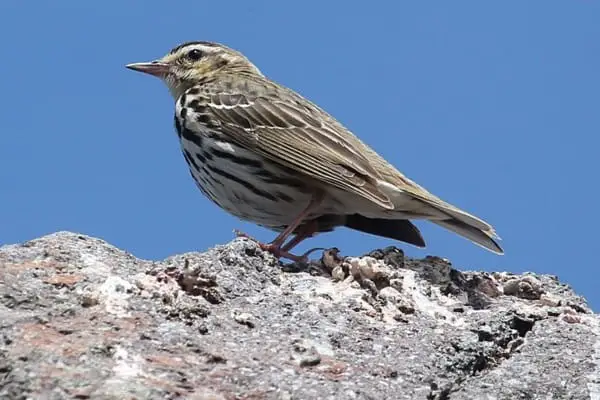
The Olive-backed Pipit is a relatively secretive and elusive bird, often found in grassy habitats or open fields. It is primarily a ground-dwelling species and spends much of its time foraging on the ground for insects and seeds.
During the breeding season, male Olive-backed Pipits can be quite vocal, singing from perches to establish territories and attract mates. Their song is a series of high-pitched, melodious notes that can carry over long distances. Males may also perform flight displays, soaring and fluttering in the air while singing.
Olive-backed Pipits are known for their migratory behavior, undertaking long-distance journeys between their breeding and wintering grounds. They can cover thousands of kilometers during migration, often traveling in flocks. These birds are diurnal and mainly active during the day.
While they are primarily ground foragers, Olive-backed Pipits may also make short flights to catch insects in mid-air. They have a distinctive bouncing or hopping movement while on the ground, often flicking their wings and tail.
In terms of social behavior, Olive-backed Pipits are generally solitary or found in small groups outside of the breeding season. They can be somewhat territorial, defending their feeding and nesting areas from other individuals.
Habitat
The Olive-backed Pipit is typically found in a variety of open habitats, particularly grasslands, meadows, and open fields. It favors areas with low vegetation and sparse shrubs, including grassy slopes, moorlands, and heathlands.
During the breeding season, it inhabits higher-altitude regions such as the subalpine and alpine zones in mountainous areas. In these habitats, it can be found nesting on the ground among grasses and moss, often near rocks or other small obstructions for additional cover.
During the non-breeding season and migration, the Olive-backed Pipit may occupy a broader range of habitats, including open woodlands, agricultural fields, marshes, and coastal areas. It is also known to occur in disturbed habitats such as grassy clearings, fallow lands, and even urban parks and gardens.
Range
The Olive-backed Pipit is not a native species to Hawaii. It breeds in Siberia, ranging southwards to the Himalayan region, Japan, and the Kurile Islands. During the winter, it migrates to regions south of its breeding range, including India, Southeast Asia, and the Philippine Islands.
While there has been a documented occurrence of a flock of Olive-backed Pipits on Kure, one of the Hawaiian Islands, it is considered a rare vagrant to the Pacific region. The sighting on Kure in 1983 is notable as it suggests the possibility of transoceanic migration from Asia to Hawaii.
Conservation Status
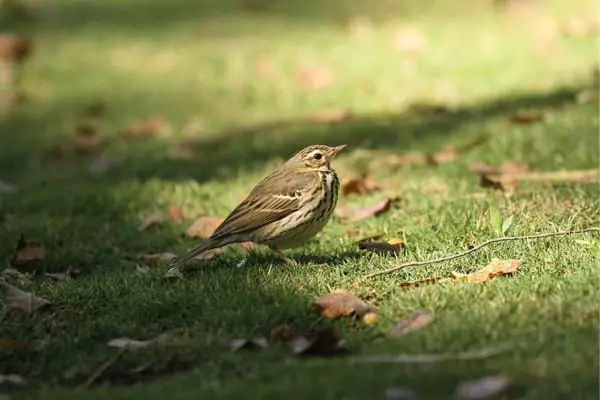
The conservation status of the Olive-backed Pipit is currently assessed as Least Concern by the International Union for Conservation of Nature (IUCN). While there is no specific population estimate for this species, it has a relatively wide distribution and is not believed to be experiencing significant population declines.
Interesting Facts
1. Camouflage
Olive-backed Pipits have excellent camouflage, which helps them blend in with their grassy habitats. Their olive-brown and buff plumage provides effective camouflage, making them difficult to spot among the vegetation.
2. Vocalizations
Male Olive-backed Pipits are known for their beautiful and melodious songs, which they use to establish territories and attract mates during the breeding season. Their songs consist of a series of high-pitched, melodious notes.
3. Subtle plumage
The plumage of Olive-backed Pipits is subtle but attractive, with a mix of olive-brown and buff colors on their upperparts. They have a whitish underbelly with streaks of dark brown or black on the breast and flanks.
4. Migratory behavior
Olive-backed Pipits are remarkable migrants, covering long distances during their seasonal journeys. They undertake challenging migrations across diverse landscapes, including mountain ranges and open seas.
Frequently Asked Questions
1. Are Olive-backed Pipits common or rare?
Olive-backed Pipits are generally considered to be widespread but not abundant. They are not as commonly observed compared to some other bird species.
2. Are Olive-backed Pipits social birds?
Olive-backed Pipits are generally solitary birds, especially outside of the breeding season. However, they may form small groups during migration or in areas with abundant food resources.
3. Do Olive-backed Pipits engage in any courtship displays?
Male Olive-backed Pipits may perform flight displays during the breeding season, soaring and fluttering in the air while singing to attract females and establish their territory.
4. How long do Olive-backed Pipits live?
The average lifespan of Olive-backed Pipits is not precisely known, but it is estimated to be around 2 to 3 years in the wild. Some individuals may live longer, potentially up to 5 years or more.
